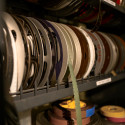New study shows phonics is critical for skilled reading
By developing a computer model that mimics how children learn to read, two researchers from UW–Madison and Stanford University track the development of a skilled reader, ultimately showing that phonics gives readers an edge, especially early on.
This finding, described in the July issue of Psychological Review, suggests that teaching young children the relationships between spellings and sounds – or phonics – not only makes learning to read easier, but also allows the flourishing of other skills that lead to faster, better reading.
When it comes to reading, there’s a general disconnect between educational practices and basic research, despite the fact that science has started to develop a picture of the biological and behavioral processes that guide how we read, says Mark Seidenberg, UW psychology professor and co-author of the paper.
“Given the role of literacy in society,” he says, “it’s important to understand how the process of reading works.”
To provide a clearer picture of the reading process, Seidenberg and former graduate student Michael Harm, now at Stanford University, designed a computer model that learns to read just like children. It may not simulate everything that goes on in a classroom, says Seidenberg, but the model uses the same principles and factors that guide reading ability.
For example, the researchers first exposed the model to sounds until it developed a spoken language vocabulary, just as toddlers do as they listen to the speech around them before reading instruction even begins. Once the model could figure out meaning from sounds, the researchers showed it word spellings. Then, they asked it to read a variety of words and figure out what they meant. The model could use sounds, visual patterns or a combination of both.
“The beauty of the model is that you can test out many different ways of teaching how to read words,” says Seidenberg. “You can see what happens if you give the model a phonics-type experience, or if you just emphasize the connections between spelling and meaning.”
By training the model to become an efficient, skilled reader that learned to read as most children do, the researchers could determine what methods – ones that include or exclude phonics – produce better readers.
The model ultimately learned to read 6,000 words, correctly pronouncing and computing the meaning of almost all of them. Based on the results, it accomplished this not by relying solely on one approach to reading, but by combining the two to hone in on meaning much more rapidly. This balance, however, shifts as a reader becomes more skilled.
“It’s very clear that in the early stages of beginning to read, the model – and child – learns more rapidly if the connections among spelling and sound and meaning are established,” says Seidenberg, explaining that the spellings are written representations for sounds young readers already know.
Once the model learns more words and spellings, including ones like “plain” and “plane” that sound alike but carry different meanings, it begins to rely more on the visual method, which requires one less step than the phonics-based approach, says Seidenberg.
But, as he explains, “you can’t go straight to that end point. Learning to read words visually is hard – it takes a lot of practice because the mapping between spelling and meaning is almost arbitrary.
“Sounding things out gradually strengthens the visual process until it becomes more efficient and does more of the work,” he adds.
While one approach to reading may work harder at certain points in a reader’s career, skilled readers use both sounds and spelling at the same time for reading almost all words.
Many people hear a “voice in the head” while they read and researchers have debated whether this helps or hinders reading, says Seidenberg. The voice, an example of how sounds continue to help readers determine meaning, actually helps us read, he adds.
“This idea contradicts the assumptions of many “speed reading” courses, which tell readers to ‘shut off’ the voice in the head,” he says.
In addition to providing a better understanding of the processes that guide how we make meaning of what we read, the study also begins to bridge the gap between how to teach reading and how we actually read.
“If you have a teaching method that discourages learning the connections among spelling, sound and meaning, you make the task of learning to read much harder for the child,” says Seidenberg. “You also leave out an important component of what ultimately makes us skilled readers.”
Tags: research




